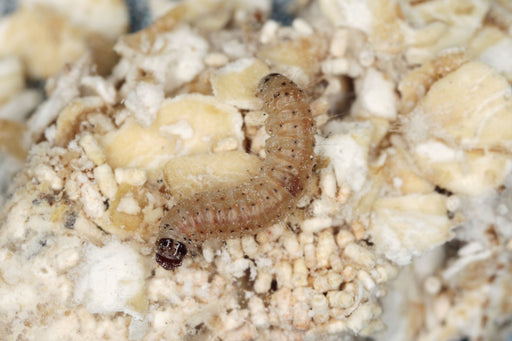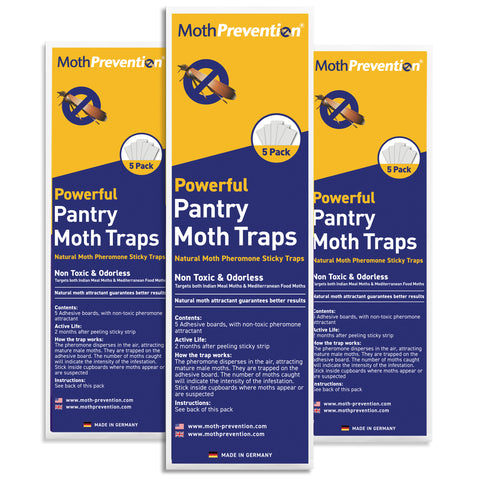HOW MOTHPREVENTION® PANTRY MOTH TRAPS WORK
The pantry moth trap sticky strip is a natural pantry moth killer that works through being impregnated with a natural attractant. Adult male pantry moths become stuck to the strip, enabling you to monitor the seriousness of your moth problem, break the breeding cycle by killing the male moths and help get rid of pantry moths over time. This natural pheromone trap mimics the scent released by the female moth to attract the male
Pheromone Traps work by attracting the Adult Male Pantry Moth only: Females, Juveniles and un-targeted moths will not be attracted
INSTRUCTIONS FOR PANTRY MOTH TRAPS
Full Instructions are included with your Pantry Moth Traps
As part of your treatment, we recommend disposing of all infected foodstuffs, cleaning all cupboards thoroughly and using sealable storage containers for all cereals, flour, grains and similar foodstuffs that might become infected
Continue to use our pantry moth traps after treatment to monitor for any signs of subsequent pantry moth activity
Please note that this product is non-toxic and does not kill moth larvae - if you have a serious infestation and significant evidence of Pantry Moths in your home, you may need one of our Pantry Moth Killer Kits to supplement your Pantry Moth Traps
Useful to know:
- Refrigerate your glue strips to make them easier to peel.
- Glue on your hands? Rub in a little cooking oil and then wash with soap and warm water
Product Code: AMOTH01803
Are these Indian Meal Moth Pheromone Traps and Mediterranean Flour Moth Traps able to catch clothes moths?
The pheromones in MothPrevention Moth Traps are designed specifically to attract the type of moth you are trying to eradicate. If your moth infestation is also in your closet, it's likely you have multiple types of moths.
If you have Moths in your closet, you require our highly effective pheromone clothes moth traps - but you may also need a clothes moth killer kit if the moth infestation has taken hold.
If you're struggling to identify the type of moths in your house, we created a number of resources to help you identify the types of moths in your house.
Your Questions About Pantry Moths & Pantry Moth Traps Answered...
We’ve taken the most common questions we hear from customers about Pantry Moths and answered them in brief below - links to further reading and resources are included where helpful.
Do you have any of the following questions? Browse the answers below:
Pantry moths are household pests that search for stored food in which to lay their eggs. When the food moth larvae hatch from pantry moth eggs they are then in the right place to eat the food to get sustenance for growing and eventually pupating into adult pantry moths.
The most common species found across the US, including in Hawaii and Alaska, are Indian Meal Moths (Plodia Interpunctella) and Mediterranean Food Moths (Ephestia kuehniella).
Common names for these two species also include meal moths, flour moths, food moths and kitchen moths.
MothPrevention® traps for pantry moths contain powerful pheromones targeting both these species.
We have customers who have had a wide variety of sources of their pantry moth infestations. From living close to flour mills, cereal mills, from neighboring properties, from bringing infested dried food sources into the home, and especially common is bringing into the home infested bird seed and pet food.
Pantry moths do spread over wider areas and are now a global pest from Asia, across Europe, to the Americas.
Pantry Moths arriving in your home or business need to have a source (where do they come from?) and food for the adult (flying) Pantry Moths to target for egg-laying - this perpetuates their life cycle. In addition, they need warmer temperatures for at least part of the year to trigger pupation / development of the larvae into adult moths.
Food may either exist in your home already (see below) and pantry moths enter in search of the food. Alternatively, they may be brought into the home. As an example, one of our customers runs a corner store and sells bird seed and pet food. The wholesaler had supplied the bird seed infested with pantry moth larvae which then caused an infestation in the store. Sales to customers from the store can then result in spreading the problem. Homes infested can create problems for neighbors, especially in cities or apartment buildings where homes are close together.
We hope this answers your question “what causes pantry moths?”
The main factors in providing the ideal conditions for pantry moths are the preference for dark, undisturbed places, and the presence of the right food sources.
Pantries and kitchen cupboards that are not used frequently, or at least shelves within those places that are relatively undisturbed on a regular basis are the ideal locations. Likewise pantry moths like outbuildings and other storage areas.
The food sources are typically flour (hence the common reference to ‘flour moth’), cereals, rice, pasta, nuts, seeds, dried pet food, bird seed and similar dried foodstuffs.
Access to the food is clearly important - a typical scenario would be a large walk-in pantry that is shelved, with open packets of flour or cereal at the back of a less used shelf away from direct, bright light. Left undisturbed, the adults can lay their eggs, the larvae hatch and eat without pressure until they are ready to pupate into adults, completing a full lifecycle.
Adult female pantry moths that have mated only live for about a month but in that short time can lay around 200 eggs. So, without control, they can very quickly get out of hand and cause an infestation.
As above, Pantry Moths need the right environment to breed and food source to sustain their newly hatched larvae, although it's important to note that pantry moth larvae can live up to 2 years before pupating.
To recap, look for relatively undisturbed, darker areas with an open source of food for the pantry moth larvae. Consider where the moths may have come from - brought into the home in previously infected food or coming into the home looking for food and finding the ideal breeding conditions?
If the pantry moths have not come into the house through food already infested with pantry moth eggs or pantry moth larvae, you will want to be looking for other entry points and external sources.
Any opening into the house will provide easy access - doors, windows, heating ducts and chimneys are all entry points. We have had customers with moth infestations that have arisen through hot air heating systems and in chimneys. Fly screens on doors and windows help keep out most insect pests.
We've provided an extensive 10 step guide explaining how to get rid of pantry moths which you can read by clicking here.
Briefly summarising the steps to getting rid of pantry moths:
The first thing to do is to install pantry moth traps to help reduce the population over time by trapping the males, and breaking the breeding cycle - pantry moth traps are infused with a female moth pheromone to specifically attract the males. This also gives you a visual signal as to how bad your infestation is.
A declining catch rate over time shows that you are winning that battle, although it should be noted that juvenile and female moths will not be attracted to the pantry moth traps.
Next you need to locate the source of the infestation - a crucial step that many people do not take; without eradicating the source of the problem you will not be able to eradicate the pantry moths!
Removing infested food and through cleaning of all surfaces, and the application of a non-toxic (to humans) residual pesticide is required. And then any remaining non-infested food should be placed in clean, airtight containers.
Lastly, keep your pantry moth pheromone traps in place to monitor and defend against a repeat occurrence - these will need to be replaced every 2 months.
For more information, please read our Blog article How Do I Get Rid Of Pantry Moths? - 10 Steps To Pantry Moth Prevention
As mentioned above, it is so important to try to locate the source of the pantry moth infestation - this will determine how successful you will be in your efforts to get rid of pantry moths.
If, and only if, you have just seen the initial entrance of pantry moths into your home, then the use of pantry moth traps alone may deal with the problem quickly. However, if you already have an infestation, and by that we mean a food source infested with pantry moth eggs and / or larvae, then you need to deal with that source of the problem.
Guidance on how to get rid of pantry moths beyond just using traps for pantry moths is contained in our Blog article How Do I Get Rid Of Pantry Moths? - 10 Steps To Pantry Moth Prevention
It is hard to make a claim that you will not see pantry moths again after dealing with an infestation because they could return again the following year or be accidentally brought in to the home, but you CAN get to the bottom of an existing infestation and completely get rid of pantry moths for your current infestation.
To get rid of your current infestation for good requires an absolute focus on finding and removing the source of the infestation, as well as any evidence of spread of the infestation.
Let’s say you had an infested packet of flour on a little-used shelf in your pantry - a common scenario where pantry moths are presented with the perfect environment for them to exist, breed and spread. To deal with this will require locating the open packet of flour, carefully removing it so as to not spread eggs and / or larvae unnecessarily, clearing the sleeves, washing down the shelves, walls, floors and paying close attention to cleaning any cracks and crevices in the pantry, treating the surfaces with a residual pantry moth spray to kill any remaining pantry moth eggs and larvae and deal with new ones arising (for 2 weeks usually); all foods are either thrown away or placed in airtight storage containers, and pantry moth traps placed to deal with any remaining adult moths present (to stop them breeding).
This all assumes that they have not spread, mated and laid eggs elsewhere. If so, a similar process in all relevant locations will be required.
To defend against further risk of infestation, regular cleaning, use of food containers for dried food in particular (seeds, nuts, flour, grains, pet food, bird seed etc.), and use of pantry moth pheromone traps are recommended. Do not leave out of date old packets lurking at the back of pantry shelves and be ever vigilant.
Any future repetition will be potentially a new population entering the house or contained in infested food brought in to the home.
To answer what kills pantry moths we’ll cover three main approaches below:
- Break the breeding cycle by use of moth pantry traps - by capturing male moths, mating will reduce and over time the population will fall - the males will be dealt with by the traps; the females will die naturally after about a month without having bred, and there will be fewer eggs and larvae. This may take several life cycles over several months depending on the severity of your infestation
- Remove access to food sources - access to dried foods encourages pantry moths (seeds, nuts, flour, grains, pet food, bird seed etc.). If there is no food accessible then any larvae present cannot eat and the lifecycle will be broken. Removing infested food sources, using airtight containers for remaining food, deep, regular cleaning routines are all important ongoing measures needed
- Use natural, non-toxic (to humans) pantry moth killer - a residual spray is highly recommended, like the one in our pantry moth killer kits - safe to use in kitchens and food storage areas, but lethal to pantry moths, eggs and larvae
Naturally we recommend using all three approaches above to be sure to deal with killing pantry moths.
To kill pantry moth larvae requires a multi-stage approach.
First, thoroughly check your kitchen storage areas, pantry, kitchen cupboards, anywhere you store dried food (for pets as well as people) - throw out any infested food carefully, avoiding any spillage which may distribute pantry moth eggs and / or larvae.
Then clean thoroughly all nearby surfaces, including walls, floors and obviously shelves. Once dry, apply a residual, natural pantry moth killer spray, which will be safe for use in kitchens - like the one we include in our pantry moth killer kits
Lastly, you will need to defend against further infestation by pantry moths in the future. Clearly, if you have brought pantry moths into the house (commonly in the form of the eggs and / or larvae) through infested food, avoid the suppliers who may have sold you that food in future because their production facility likely has issues - this is most common with dried pet food and bird seed.
Use of pheromone pantry moth traps during warmer weather when adult moths flying into the house is more of a risk will help defend against a repeat infestation
We hope this answers the question “how to kill pantry moth larvae?”
Keeping moths out of food is best done through the following:
- Keep dried food in airtight containers, especially for open packets of flour, seeds, grains, rice, cereals and pet food
- Throw out out-of-date food regularly
- Keep shelves from being overstuffed
- Clean all surfaces regularly
- Avoid buying food from suppliers that have previously been the source of a pantry moth infestation being brought into the home
- Use pheromone traps for pantry moths to break the breeding cycle of any adult pantry moths present


Indian Meal Moths are the most common species of pantry moth across the USA. Adult Indian Meal Moths are approximately ¾ inch in length with a typical wingspan of ¾ to one inch. The outer half of their forewings are bronze or dark gray in color, while the upper half are a yellowy-gray color, with a dark band between.
The adult Mediterranean Pantry Moth is a light-grey color and from ⅝ inch long, with a wingspread of about one inch. The wings are marked with two fuzzy, dark zigzagging lines (see photograph). The hind wings are a ‘dirty white’.
Pantry moths or "Indianmeal moths" are also commonly referred to as flour moths, grain moths or food moths.
Therefore all advice relating to getting rid of "Pantry Moths" is applicable to getting rid of Indianmeal Moths.
MothPrevention moth pantry traps target both Indian Meal Moths and Mediterranean Food Moths with their powerful pheromones.

The Indian Meal Moth and Mediterranean Food Moth larvae are cream / off-white with brown heads. Fully grown Indian Meal Moth larvae are usually about ½ inch long.
Where to buy pantry moth traps?
Pantry Moth Traps can be bought in hardware stores and larger outlets like Home Depot, as well as online in marketplaces such as Amazon.
Clearly we would recommend you buy our pantry moth traps, the reasons being:
- Customer reviews frequently mention that they outperform other traps customers tried previously
- We engineer our pheromones in Germany - they are exclusive to MothPrevention in the USA and are the main reason for the outperformance of our pantry moth traps - most traps on the market are cheaply made in the same factory in China, and just don’t work as well
- The design is deliberately simple - they take up less space in cupboards and pantries compared with the common ‘tent’ shaped design - and the flat layout provides easier access and better dispersal of the pheromones
- You are dealing with a family company that specializes in dealing with moth problems
- MothPrevention supplies professional pest technicians - see the video further up this page - we’re trusted by those ‘in the know’
- Lastly, unlike the other sellers of pantry moth traps, we don’t just sell you product - we’ll be with you every step of the way in dealing with your pantry moth problem - that’s why we back up your purchase with a 100% guarantee that you’ll be satisfied







